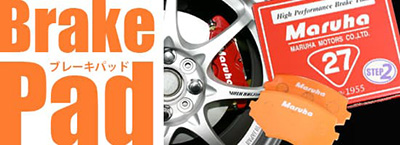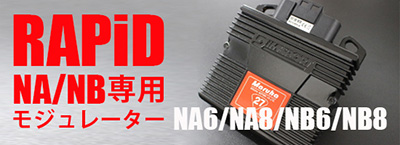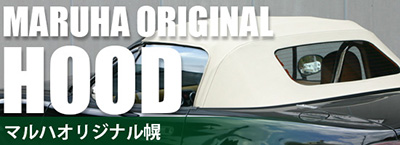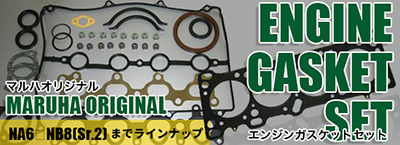Maruha Power Rod (H-beam)
We changed the design of the power rod and set up a new version, the H-beam rod.
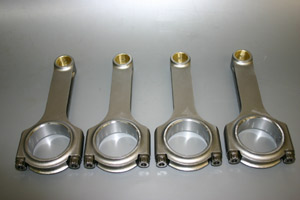
パワーロッド (H-BEAM) 標準ストローク(2024年7月〜)
code:mar07053100 For NA8NB8
¥129,800(¥118,000)
About the turbo connecting rod
Out of the engine parts the one that has to "work hard" under severe conditions is the connecting rod. In the case of engine tuning the connecting rod is a very important item that cannot be missing. The stress from high rotation and power up falls on the connecting rod. It can bend, deform, break and it might be the reason for the engine blow. Its damage might lead to serious troubles in the case of tuning too. The reason behind the connecting rod’s damage is the metal bearing.
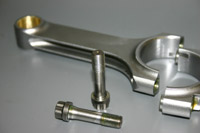
The engine metal bearing is divided into two categories: for main journal and for pin journal.
The pin journal has to operate under severe conditions.
The engine can be constructed by altering the crankshaft, by optimal control of each part’s clearance, and by securing the oil pressure and oil volume and lowering the piston’s friction.
However, even if we are very careful, the high rotation and power up is being followed by the connecting rod’s deformation.
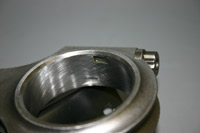
Because of the piston’s inertial force the perfect circle on the rod’s big end causes deformation (ovalization). This ovalization affects the metal bearing which is in the inner part of the rod’s big end. The bearing and the crank pin come in contact and they damage the metal. Also, there is a crack on the metal’s backside caused by this deformation and oil can flow inside. This is how fretting occurs.
The metal gets damaged on the outside, which means that in the case of tuning the strengthening of the rod is indispensable.
- H-beam
In the case of our power rod we used H-shape.
It is very useful for buckling strength and it supports weight reduction.
Keeping in mind the balance between the weight and the strength, the neck width is set to 1mm.
The weight reduction and the stiffness are contradictory elements, that’s why the setup has to be done carefully, finding the perfect balance.
The difficulty lies in the perfect setup of the parts, without concentrating only on weight reduction.
Compared to the genuine rod, Maruha’s power rod weighs 80g less (around 460g). We examined the strength with the rod manufacturer’s engineers many times.
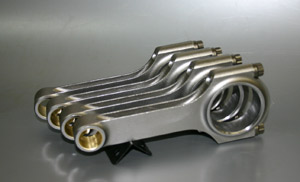
-
Heavy-duty bolt
The American company ARP, which has an established reputation all over the world, uses #2000 bolt.
The shaft diameter is bigger and that’s why certain strength is secured.
From under the bolt’s neck a waist axis with smaller diameter is used. It precisely manages the lengthening of the bolt.
The joint part of the big end's cap is produced by machining which gives it strength and helps the weight reduction.
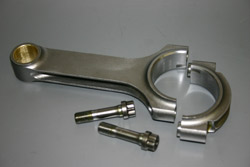
The big end’s shoulder, side and bottom are optimally thick.
The cap is being locked by the bolt and the rod shoulder is smoothly curved. In this way the stiffness level is higher. In the case of the genuine rod the cap is being fixed by nuts and that’s why it’s difficult to reach a smooth shape.
For deciding the cap’s position a high precision knock pin is being used and the cap can be firmly locked.
This kind of good positioning responds to the fretting and improves the metal load’s homogeneity.
-
About the stress at exhaust TDC:
The engine rotates on high revolution.
Many people might think that when talking about the power (explosion) we have to consider the bore’s diameter, stroke, metal width, compression ratio, ignition timing, output etc. and that’s why the rod has to be strengthened. All this is true, however, there is one more thing we have to consider. It is the rod’s stress at the exhaust TDC.
After the explosion in the combustion chamber, the piston starts rising. Its top position at this time is expressed by the exhaust TDC. After the exhaust process ends, it becomes the main point of the intake process.
In the case of the compression top dead center break occurs on the top of the piston.
However, in the case of the exhaust top dead center, there is no such break, that’s why the rising piston’s inertial force is trying to tear off the rod and tries to break out penetrating the engine head.
However, the crankshaft forces it to change direction downwards.
That’s the situation of the exhaust top dead center.
As the piston’s weight grows and the number of revolutions rises, the connecting rod’s load increases and that’s why it leads to the big end’s deformation and the neck’s damage.
Just like in the case of BP 2.1L and other circuit engines, the rod is used for tests, functions without problems and gives proof even at circuit tries. -
Small end
The small end is processed by full floating through the bush.
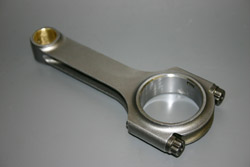
The inner diameter unlike in the case of the 20mm genuine piston is 22mm used for Maruha’s turbo piston. An oil orifice is set up on top of the small end and the dripping oil becomes the lubricant. -
Weight balance
Maruha’s power rod controls the small end and the big end separately.
Generally it is being controlled by the unit weight. When we unite the rod with the engine, the big end is united with the crank pin. The small end unites with the piston through the piston pin.
In other words from the view point of the inertial force it works divided into crank side and piston side, that’s why the balance of each end is important.
NEW OIL!!

ESTER27 Full Synthetic♪
NEW TOPICS



CARBON TIMING COVER

